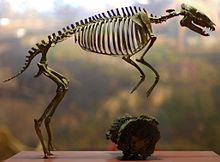Eohippus
| Eohippus Temporal range: Ypresian,
| |
|---|---|

| |
| Reconstructed skeleton, National Museum of Natural History, Washington, D.C., United States | |
| Scientific classification | |
| Domain: | Eukaryota |
| Kingdom: | Animalia |
| Phylum: | Chordata |
| Class: | Mammalia |
| Order: | Perissodactyla |
| Family: | Equidae |
| Genus: | †Eohippus Marsh, 1876 |
| Species: | †E. angustidens
|
| Binomial name | |
| †Eohippus angustidens (Cope, 1875)
| |
| Synonyms | |
| |
Eohippus is an extinct genus of small equid ungulates.[1] The only species is E. angustidens, which was long considered a species of Hyracotherium (now strictly defined as a member of the Palaeotheriidae rather than the Equidae). Its remains have been identified in North America and date to the Early Eocene (Ypresian stage).[2]
Discovery
[edit]
In 1876, Othniel C. Marsh described a skeleton as Eohippus validus, from Greek: ἠώς (eōs, 'dawn') and ἵππος (hippos, 'horse'), meaning 'dawn horse'.[citation needed] Its similarities with fossils described by Richard Owen were formally pointed out in a 1932 paper by Clive Forster Cooper. E. validus was moved to the genus Hyracotherium, which had priority as the name for the genus, with Eohippus becoming a junior synonym of that genus. Hyracotherium was recently found to be a paraphyletic group of species, and the genus now includes only H. leporinum. E. validus was found to be identical to an earlier-named species, Orohippus angustidens Cope, 1875,[3] and the resulting binomial is thus Eohippus angustidens.
Description
[edit]Eohippus stood at about 12 in (30 cm), or three hands tall, at the shoulder.[4] It has four toes on its front feet and three toes on the hind feet, each toe ending in a hoof. Its incisors, molars and premolars resemble modern Equus. However, a differentiating trait of Eohippus is its large canine teeth.[4][5]
Stephen Jay Gould comments
[edit]In his 1991 essay, "The Case of the Creeping Fox Terrier Clone",[6] Stephen Jay Gould lamented the prevalence of a much-repeated phrase to indicate Eohippus size ("the size of a small Fox Terrier"), even though most readers would be quite unfamiliar with that breed of dog. He concluded that the phrase had its origin in a widely distributed pamphlet by Henry Fairfield Osborn, and proposed that Osborn, a keen fox hunter, could have made a natural association between his horses and the dogs that accompanied them.[6]
See also
[edit]- Evolution of the horse- more broad info on the topic
- Mesohippus
- Protohippus
References
[edit]- ^ MacFadden, Bruce J. (18 March 2005). "Fossil Horses--Evidence for Evolution" (PDF). Science. 307 (5716): 1728–1730. doi:10.1126/science.1105458. PMID 15774746. S2CID 19876380. Retrieved 13 July 2024.
- ^ Froehlich, David J. (2002). "Quo vadis eohippus? The systematics and taxonomy of the early Eocene equids (Perissodactyla)". Zoological Journal of the Linnean Society. 134 (2): 141–256. doi:10.1046/j.1096-3642.2002.00005.x.
- ^ Cope, E. D. (1875). Systematic Catalogue of Vertebrata of the Eocene of New Mexico, collected in 1874. p. 22. Retrieved 13 July 2024.
- ^ a b "Hyracotherium (Eohippus)". University of Guelph. Archived from the original on 2020-11-13.
- ^ "Eohippus | Size & Facts | Britannica". britannica.com. Retrieved 2022-09-27.
- ^ a b Gould, S. J. (1991). "Essay 10: The case of the creeping fox terrier clone". Bully for Brontosaurus: Reflections in Natural History. W.W. Norton & Co. ISBN 978-0-393-02961-1.









